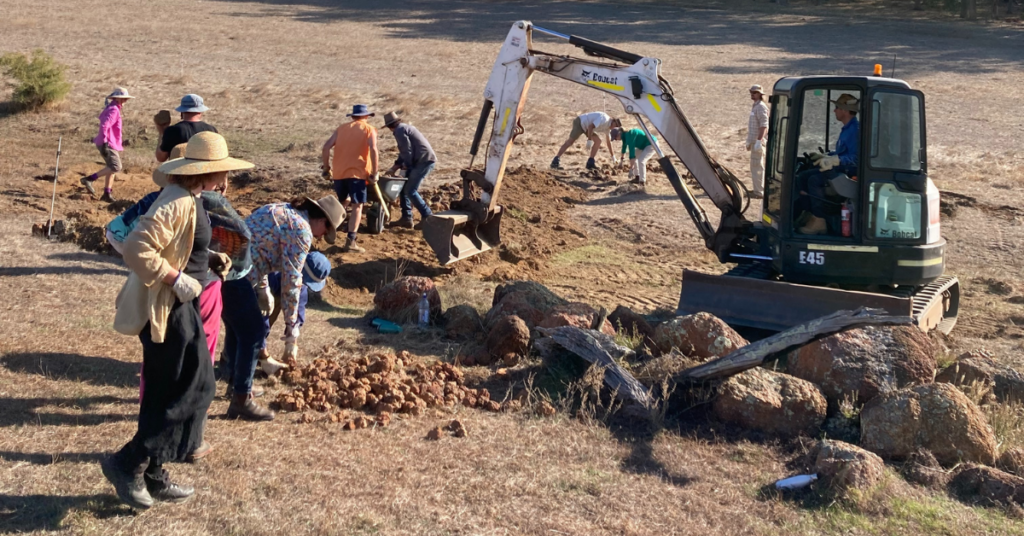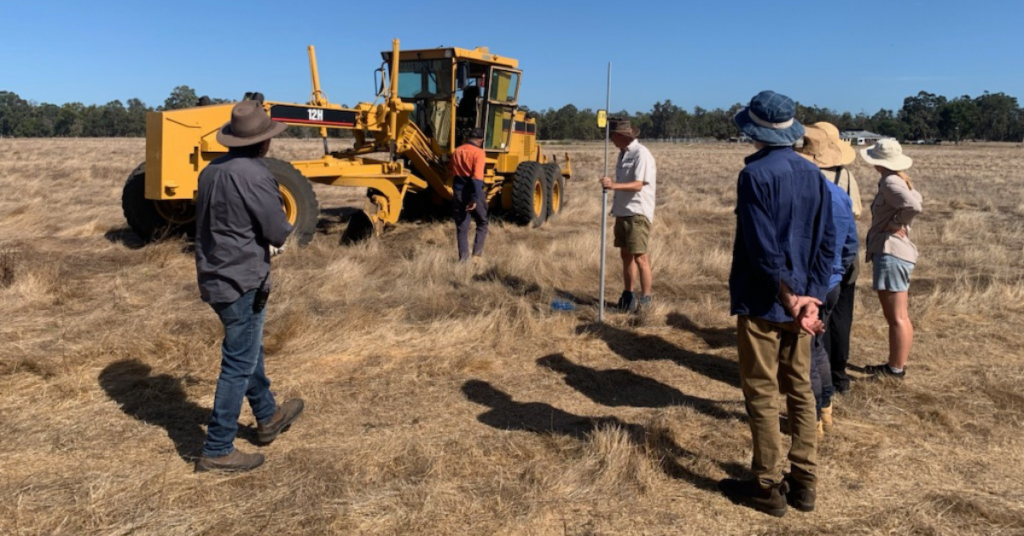
Building a leaky weir at Sunnyside Farm.

Wilga Farm. Photo courtesy Tibby Tucket, RegenWA.
What is the small water cycle? Why is it broken? And could fixing it on your farm create more water in a drying climate?
South West NRM’s Sustainable Agriculture Facilitator attended Mulloon Institute’s Boots on Ground event this month which was organised by RegenWA as a part of their Community of Practice project funded by the Australian Government’s Future Drought Fund.
The goal? Repair the small water cycle by teaching landholders to implement landscape rehydration projects.
But what exactly is the small water cycle? It refers to the circular process of rainfall landing, being used by plants which then transpire and send moisture back up into the atmosphere. That moisture then condenses into rain and falls again to continue the cycle.
For the small water cycle to work, green, actively photosynthesising plants are required.
The Problem
The problem this cycle encounters in our agricultural landscapes is that land has been cleared of trees and shrubs and replanted with annuals which are not photosynthesising year-round.
The process was further explained on the day by Landscape Planner and Hydrologist Lance Mudgway who is mentoring landholders and building local capacity for landscape rehydration.
“One of the key elements in the water cycle is plants, and we’ve lost them because we’ve cleared the landscape of perennial trees and bushes,” Lance said.
“That really upsets where water moves in the landscape and in the atmosphere.”
In GGA’s recent podcast, Lance explained how WA’s rainfall has dropped by 15-20% and although climate change plays its part, he points to an analysis that indicates rainfall decline is also due to the breakdown of the small water cycle caused by clearing (Andrich & Imberger, 2013).
Boots on Ground Event
Mulloon Institute is demonstrating how the water cycle can be repaired at Wilga Farm and Sunnyside Farm.
For the Boots on Ground event about 12 landholders came together to learn what landscape rehydration involves and see the landscape from a hydrologist’s point of view.
At Wilga Farm, participants walked the paddock planning the course of the contour banks using surveying equipment which was then graded.
The contour bank followed the same elevation all the way across the property and is designed to spread water out, stopping it pooling or rushing to low points in the land.
These contour banks will be fenced off and revegetated, creating a biodiversity corridor for local species with the intention of increasing resilience, particularly in regard to insect pests.
At Sunnyside Farm, near Bridgetown, the group discussed how to slow water down as it moves through a seasonal creek running through the valley of the property.
What these farmers discovered
The creek was one of the drawcards that made farming couple Michael and Marika Coghill buy the property, but they had noticed the water drying up earlier and earlier over recent years.
The creek used to be a small floodplain marsh which is still intact in the neighbouring bush upstream but has virtually disappeared on the farmland due to historical erosion and incision of the creek.
By slowing the water down, the sediment coming in from the bushland has time to settle and deposit native seeds and nutrients on their property instead of washing soil off their property.
The Coghills also plan to establish perennial pastures for grazing cattle so keeping the available water on their property for longer is essential to the sustainability of their operation.
Lance led event participants through the landscape describing its hydrology. The group then worked together to build a leaky weir to slow water down.
This leaky weir was built strategically under expert guidance in straight sections of the waterway using rocks and wooden debris carefully placed then filled and packed down with an excavator.
“Once we’ve re-supported nature to do what it does best, it provides so much for us in terms of nutrient cycling, energy cycling and water cycling,” Lance said.
“If nature can do all these things for you, like cycling nutrients, then you don’t have to apply so much in the way of fertilisers. It makes the landscape more resilient.
“This means you’ve got more time to spend with your family, your community and you’ve also got more money to re-invest in the property or go on holiday.”
Find out more
If you would like to know more about landscape rehydration, watch this video of South West NRM’s 2025 Soil Health Champion Warren Pensini of Paraway Farm. He has been rehydrating his landscape with the mentorship of Mulloon Institute for the past 4 years.
Visit Mulloon Institute for more information or RegenWA’s project page.
Reference:
Andrich, M & Imberger, J. (2013): The effect of land clearing on rainfall and fresh water resources in Western Australia: a multi-functional sustainability analysis. International Journal of Sustainable Development & World Ecology, 20 (i6), p 549-563. https://doi.org/10.1080/13504509.2013.850752
